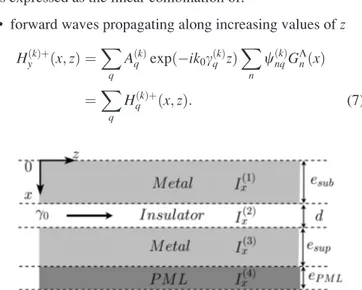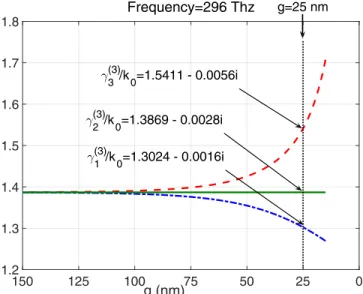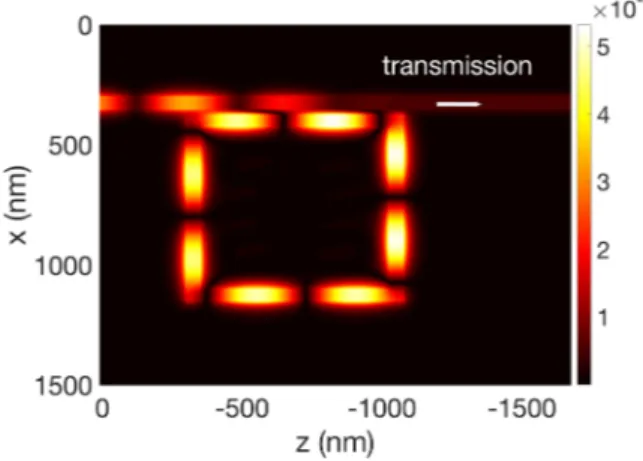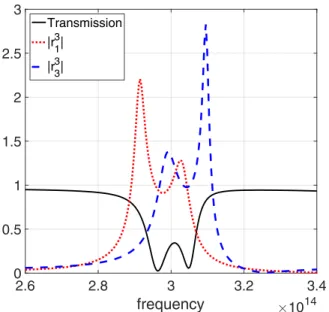HAL Id: hal-01658978
https://hal.uca.fr/hal-01658978
Submitted on 8 Dec 2017
HAL is a multi-disciplinary open access
archive for the deposit and dissemination of sci-entific research documents, whether they are pub-lished or not. The documents may come from teaching and research institutions in France or abroad, or from public or private research centers.
L’archive ouverte pluridisciplinaire HAL, est destinée au dépôt et à la diffusion de documents scientifiques de niveau recherche, publiés ou non, émanant des établissements d’enseignement et de recherche français ou étrangers, des laboratoires publics ou privés.
Polynomial modal method for analysis of the coupling
between a gap plasmon waveguide and a square ring
resonator
Kofi Edee
To cite this version:
Kofi Edee. Polynomial modal method for analysis of the coupling between a gap plasmon waveguide and a square ring resonator. Journal of Applied Physics, American Institute of Physics, 2017, 122 (15), pp.153102 - 153101. �10.1063/1.4999025�. �hal-01658978�
Polynomial modal method for analysis of the coupling between a gap plasmon
waveguide and a square ring resonator
Kofi Edee
Citation: Journal of Applied Physics 122, 153102 (2017); doi: 10.1063/1.4999025 View online: http://dx.doi.org/10.1063/1.4999025
View Table of Contents: http://aip.scitation.org/toc/jap/122/15 Published by the American Institute of Physics
Articles you may be interested in
Voltage tunable plasmon propagation in dual gated bilayer graphene Journal of Applied Physics 122, 153101 (2017); 10.1063/1.5007713
Polynomial modal method for analysis of the coupling between a gap
plasmon waveguide and a square ring resonator
KofiEdeea)
Universit!e Clermont Auvergne, Institut Pascal, BP 10448, F-63000 Clermont-Ferrand, France and CNRS, UMR 6602, Institut Pascal, F-63177 Aubie`re, France
(Received 4 August 2017; accepted 2 October 2017; published online 17 October 2017)
When a Metal-Insulator-Metal waveguide is coupled with a ring resonator, one expects, for a given integer referring to cavity mode number, exactly one resonance phenomenon. However, numerical simulations of the spectrum of the transmission of the structure highlight two resonances around certain values of the resonance wavelength. This phenomenon was numerically studied thanks to a Finite Difference Time Domain method. Until now, and to my knowledge, this phenomenon is linked to a correlation between the standing waves forming in the ring at the resonance wavelength and the faces and corners of the ring. In this document, I present a new physical analysis and interpretation of the transmission spectrum anomaly of the square ring resonator. By using an efficient polynomial modal method, I show that this phenomenon is due to the interference of hybrid modes of the superstructure.Published by AIP Publishing.https://doi.org/10.1063/1.4999025
INTRODUCTION
Classical circular waveguides’ ring resonators1 have been widely studied. They have been used in photonics inte-grated circuits and dense wavelength division multiplexing optical communication systems such as filters, add-drop cou-plers, and a wavelength-division multiplexer. In 2007, a square ring resonator (SRR) was studied by Hosseini and Massoud.2This SRR can be used as an ultracompact direc-tional add-drop coupler between two parallel waveguides. Several years later, other authors extended the scope of this system to realize, for example, plasmon flow control in T-splitters and waveguide cross junctions.3Recently in 2015, a novel surface plasmon based square-shaped ring resonator with a bending Metal-Insulator-Metal (MIM) waveguide at the optical spectral range was investigated by Yanet al. in Ref. 4. The feature of this structure was often analyzed thanks to a finite difference in the time domain (FDTD) method and its transmission spectrum may highlight an anomaly. This anomaly was observed and explained first in Ref. 2 by suggesting a correlation between the standing waves forming in the ring at the resonancekgand the faces
and corners of the ring. Although these observations and analysis seem relevant, it is possible to deepen and complete them by a modal analysis of the structure. Thus I present in this paper another interpretation of this phenomenon which relies on the multimode character of this type of structure. My analysis is based on the propagation of plasmons through the interference of two modes. These two modes result from the coupling between the waveguide bus and the resonator. Since the feature of devices at hand is linked to a plasmon resonance phenomenon, it may be successfully treated as an eigenvalue problem with specific boundary conditions, i.e., a boundary value problem. This boundary value problem is efficiently solved throughout a polynomial modal method
based on Gegenbauer expansion (MMGE).5–8 I first show that this numerical scheme allows avoidance of any uncer-tainties in the numerical model. A new physical analysis and interpretation of the transmission spectrum anomaly is then suggested.
STATEMENT OF THE PROBLEM
Figure 1shows a typical filter based on the plasmonic filter structure. It consists of a MIM waveguide and a SRR. At the resonance wavelengthkg, one expects that the
funda-mental mode of the MIM waveguide, whose propagation constant is denoted by c0, may be coupled to the ring and
thus the flow of energy may be exchanged between resonator modes. By neglecting edge effects and evanescent modes contributions, the resonance condition is then written as
FIG. 1. Schematic of a plasmonic rectangular MIM resonator. Illustration of the staircase concatenation of the MIM resonator according to the (Oz) and (Ox) directions. The structure is divided into five layers IðkÞ
z ; k¼ 1 : 5 in the (Oz) direction and height intervals IðkÞ
x ; k¼ 1 : 8 in the (Ox) direction. The layersIð1Þ
z (resp.Ið5Þz ) correspond to the input (resp. output) waveguide bus.
a)
kofi.edee@uca.fr
0021-8979/2017/122(15)/153102/6/$30.00 122, 153102-1 Published by AIP Publishing.
2ðLxþ LzÞ ¼ ngkg: (1)
kg¼ k=neff is the guide wavelength.neff ¼ c0=k0denotes the
effective index and k is the free space wavelength. In this equation(1) the integer ng stands for cavity mode number.
k0¼ 2p=k is the wave number. Referring to Eq. (1), for a
given value of the integerngonly one resonance is expected.
However, numerical simulations of the spectrum of the trans-mission of the structure reported in Fig.2highlight two reso-nances around certain values of kg. I present here an
interpretation of this phenomenon which relies on the multi-mode character of this type of structure. My analysis is based on the propagation of plasmons through the interference of two modes, resulting from the coupling between the wave-guide bus and the resonator.
POLYNOMIAL MODAL METHOD OF MIM WAVEGUIDE MODELLING
First of all we must ensure that there are no uncertainties in our polynomial numerical model. For that purpose, we are interested in the effective indexc0=k0 of a
metal-insulator-metal waveguide, which gives us a good test of robustness of our numerical scheme.k0denotes the wavenumber. The
dielectric is assumed to be air with relative permittivity e ¼ 1. The metal is a silver whose complex relative permit-tivityesilveris characterized through the Drude model
esilverðxÞ ¼ e1% xp
xðx þ iCÞ; (2) where the bulk plasma frequency xp¼ 1:38 & 1016, the
dumping frequency of the oscillationsC ¼ 2:73 & 1013, and e1 ¼ 3:7 ¼ esilverðx ¼ 1Þ. x is the angular frequency. For
our numerical illustration, the gapd of the waveguide is set to 50 nm. The propagation constant c0 of the fundamental
mode obeys the following dispersion relation:
tanh d 2 ffiffiffiffiffiffiffiffiffiffiffiffiffiffiffiffiffiffiffiffiffi c2 0% k20eair q " # ¼ %eeair silver ffiffiffiffiffiffiffiffiffiffiffiffiffiffiffiffiffiffiffiffiffiffiffiffi c2 0% k02esilver c2 0% k20eair s : (3) Using this relation Eq.(3), the effective index c0=k0 of the
fundamentalTM0fork ¼ 1161 nm is equal to
c0=k0¼ 1:381850741177741 % 0:003033434481031i: (4)
For the numerical evaluation through the subsectional polyno-mial basis approach MMGE,5–8the slot waveguide is subdi-vided into four homogeneous domains (intervals) (Ið1Þ
x ; Ið2Þx ;
Ixð3Þ; Ixð4Þ) along the (Ox) axis with width (esub, d, esup, epml)
¼ (300, 50, 300, 50) nm and relative permittivity ðesilverðxÞ;
eair;esilverðxÞesilverðxÞÞ. See Fig.3. The eigenvalue equation(5)
eðxÞ@1 1 eðxÞ@1þ k 2 0eðxÞ $ % HyðxÞ ¼ c2HyðxÞ; (5)
is then solved in the TM polarization case and the eigenvalue corresponding to the effective index of the fundamental mode c0=k0 is computed. We present in TableIthe convergence of
the result in the case of Gegenbauer polynomials GKnðxÞ with
K ¼ 0:5 with respect to a parameter Dim. The parameter Dim denotes the number of polynomial basis functions allowing to describe the electromagnetic field onIx¼ [k¼1:4IðkÞx .The
inter-val Ið4Þ
x corresponds to the Perfectly Matched Layer (PML),
and in all the following computations, we set the PML thick-ness to epml ¼ 50 nm, and its parameters v þ ig ¼ 10 % 10i.
Cf.7for the implementation of the PML in the present polyno-mial modal method throughout a complex coordinates trans-form. An accuracy of 10%7is achieved forDim¼ 12.
MODAL ANALYSIS OF THE SRR: INTERFERENCE OF HYBRID MODES
In order to compute the transmission of the structure, throughout the polynomial modal method based on Gegenbauer polynomials GKnðxÞ expansion, the structure is
divided into nine intervalsIðkÞ
x ; k¼ 1 : 8 in the (Ox) direction
and five layers IðkÞz ; k¼ 1 : 5 in the (O, z) direction (Fig.3).
In each layerIðkÞ
z , the general solution/ðkÞðx; zÞ representing
the component
HyðkÞðx; zÞ ¼ HðkÞþy ðx; zÞ þ HðkÞ%y ðx; zÞ; (6) is expressed as the linear combination of:
• forward waves propagating along increasing values ofz HðkÞþy ðx; zÞ ¼ X q AðkÞq expð%ik0cðkÞq zÞ X n wðkÞnqGKnðxÞ ¼X q HqðkÞþðx; zÞ: (7)
FIG. 2. Transmission spectrum of the MIM resonator. Numerical parame-ters:Lx¼ Lz¼ 725 nm; g ¼ 25 nm; d ¼ 50 nm.
FIG. 3. Illustration of the numerical configuration for the modal analysis of MIM waveguide. The structure is subdivided into four homogeneous domains (intervals) (Ið1Þ
x ; Ixð2Þ; Ixð3Þ; Ixð4Þ) along the (Ox) axis with the thick-ness (esub,d, esup,epml).
• backward waves propagating along decreasing values ofz HyðkÞ%ðx; zÞ ¼ X q BðkÞq expðik0cðkÞp zÞ X n wðkÞnqGnKðxÞ ¼X q HðkÞ%q ðx; zÞ: (8) LayersIð2Þ
z ; Izð3Þ, andIzð4Þ correspond to the coupling region.
In the case when standing-waves are excited and live in the cavity, the eigenvaluescð3Þp may provide a good estimation of
their effective indices in the (O, z) direction. The major part of the coupling region may be considered as a superstructure that consists of three parallel slot waveguidesIxð2Þ; Ið4Þx , and
Ið6Þ
x with widthd¼ 50 nm. The coupled modes theory
sug-gests that when the distance between these three waveguides is large enough, there is no interaction between them and the eigenvalues of the whole superstructure are just those of each structure: the eigenvalues are three-degree degenerate; otherwise, the coupling removes or lifts the degeneracy involving a modification of the modes of each waveguide eigenmode called hybrid modes. See Fig.4. For this exam-ple, the distance between Ið4Þ
x and Ixð6Þ is set to Lz% d
¼ 675 nm. Since the distance between Ið4Þ
x and Ixð6Þ is large
enough, one of the initial modes of the isolated waveguide persistscð3Þ2 ¼ 1:3868 % 0:0028i in the waveguide Ið6Þx for all
values ofg. However, two hybrid modescð3Þ1 andcð3Þ3 appear
in the coupled waveguidesIð2Þ
x andIxð4Þfor small values ofg.
For example, for g¼ 20 nm; cð3Þ1 ¼ 1:2867 % 0:0016i and
cð3Þ3 ¼ 1:6035 % 0:0065i. As a starting point of our analysis,
consider in the input port of the coupling layerIð3Þ
z , the
nor-malised forward power sq¼ Pq=Pinc (q¼ 1, 3) associated
with the hybrid modescð3Þ1 andc ð3Þ 3 where Pinc¼ Real X q ð x Eð3Þþq ðx; 0ÞconjðHqð3Þþðx; 0ÞÞdx " # (9) and Pq ¼ Real ð x Eð3Þþq ðx; 0ÞconjðHð3Þþq ðx; 0ÞÞdx $ % : (10)
Figure 5presents the behaviour of s1;3 with respect to
different values of the frequency (freq¼ x=2p 2 ½2:7; 3:3( THz). The transmission jtj2is also reported in this figure. One can remark that the energy exchange takes place between both hybrid modes. The propagated energy is injected inside the ring cavity after passing through the cou-pling region where the energy is exchanged between weakly coupled hybrid modes. For certain frequencies, 296.6 THz, 301.2 THz, and 304.4 THz, these modes carry power of equal intensity and interfere destructively in the waveguide bus inducing extremely weak field in the transmission, or constructively, inducing excitation of the output port. Figures6,7, and8present the modulus of the magnetic field Hy(x,z) at the resonance frequencies 296.6 THz, 301.2 THz, and 304.4 THz. At all these frequencies, the ring resonator is always excited, but the interference process does not cancel the field in the waveguide bus at 301.2 THz contrary to the frequencies 296.6 THz and 304.4 THz where only a weak field is induced in the transmission port.
FIG. 4. Illustration of the lift of degeneracy of eigenmodes of the superstruc-ture for g2 ½15; 145( nm. Numerical parameters: frequency ¼ 296 THz, Lx¼ 725 nm; d ¼ 50 nm.
FIG. 5. Normalized forward power spectras1(resp.s3) associated with the
eigenmodecð3Þ1 (resp.cð3Þ3 ) forg¼ 25 nm. Numerical parameters: Lx¼ Lz ¼ 725 nm; d ¼ 50 nm.
TABLE I. Convergence of the effective indexc0=k0of the modeTM0
com-puted thanks to modified Gegenbauer polynomials GK
nðxÞ with K ¼ 0:5. Numerical parameters: d¼ 50 nm; esub¼ esup¼ 300 nm, epml¼ 50 nm; v %ig ¼ 10 % 10i; k ¼ 1161 nm.
Dim effective index
6 1.381866066132478 - 0.003034206565412i 12 1.381850837595450 - 0.003033438956998i 18 1.381850741448333 - 0.003033436438067i 24 1.381850741387773 - 0.003033436451930i 30 1.381850741414873 - 0.003033436469400i 36 1.381850741426127 - 0.003033436500549i 42 1.381850741621650 - 0.003033436337988i 48 1.381850741453263 - 0.003033436384211i 54 1.381850741586496 - 0.003033436562868i 60 1.381850741240158 - 0.003033436406518i
ELECTROMAGNETICALLY INDUCED TRANSPARENCY BEHAVIOUR OF THE SRR
Let us first consider a set of four classical oscillators coupled through a weak spring with eigen-frequencies x1=2p, x2=2p; x3=2p; x4=2p and damping constants c1,c2,
c3, andc4. The coupling coefficients of these four oscillators
are denoted by!ij,i; j2 f1; 2; 3; 4g. We assume that they are
submitted to two driving forces with the same circular
frequency x and amplitudes a1 and a4. If we denote by
xiði ¼ 1; 2; 3; 4Þ the amplitudes of these oscillators, then it
can be easily demonstrated that the system of differential equations describing the motion is given by
d2x 1 dt2 þ c1 dx1 dt þ x1x1þ !12x2þ !13x3þ !14x4¼ a1e ixt d2x 2 dt2 þ c2 dx2 dt þ x2x2þ !21x1þ !23x3þ !24x4¼ 0 d2x 3 dt2 þ c3 dx3 dt þ x3x3þ !31x1þ !32x2þ !34x4¼ 0 d2x 4 dt2 þ c4 dx4 dt þ x4x4þ !41x1þ !42x2þ !43x3¼ a4e ixt: 8 > > > > > > > > > > > > < > > > > > > > > > > > > : (11)
The steady-state harmonic solutions for the displace-mentsxiðtÞ are
xiðtÞ ¼ cieixt: (12)
It is then possible to exhibit a specific shape that combines Lorentz and Fano resonances and an interference phenome-non of some of these oscillators for suitable chosen values of the parameters of this coupled system.
Figures 9, 10, and 11 present the spectral responses jc2ðxÞj and jc3ðxÞj for different values of the parameters of
c2and c3. The remaining numerical parameters are:x1=2p
¼ 2:93 s–1
, x2=2p ¼ 2:96 s–1, x3=2p ¼ 3:04 s–1, x4=2p
¼ 3:09 s–1
, c1¼ c4¼ 0:2; !12¼ !21¼ !23¼ !32¼ !34¼ !43
¼ 0; !13¼ !31¼ !24¼ !42¼ 0:05; a1¼ a4 ¼ 1; a2¼ a3¼ 0.
In Fig.9,c2¼ c3¼ 0:5, while in Fig. 10,c2¼ c3¼ 0:4 and
these parameters are equal to c2¼ c3¼ 0:3 in Fig. 11. We
remark that the shape of the curves around the interference area is essentially driven by the values of the damping con-stantsc2andc3of oscillators 2 and 3. Therefore, the number
FIG. 6. Modulus of Hyðx; zÞ at frequency 296.6 THz, for g ¼ 25 nm. Numerical parameters:Lx¼ Lz¼ 725 nm; g ¼ 25 nm; d ¼ 50 nm.
FIG. 7. Modulus of Hyðx; zÞ at frequency 301.2 THz, for g ¼ 25 nm. Numerical parameters:Lx¼ Lz¼ 725 nm; g ¼ 25 nm; d ¼ 50 nm.
FIG. 8. Modulus of Hyðx; zÞ at frequency 304.4 THz, for g ¼ 25 nm. Numerical parameters:Lx¼ Lz¼ 725 nm; g ¼ 25 nm; d ¼ 50 nm.
FIG. 9. Fano resonance illustration with two coupled oscillators. Numerical parameters: x1=2p ¼ 2:93; x2=2p ¼ 2:99; x3=2p ¼ 3:04; x4=2p ¼ 3:09; c1 ¼ c4¼ 0:2; c2¼ c3¼ 0:5; !13¼ !31¼ !14¼ !41¼ 0:05; a1¼ 1 ¼ a4¼ 1.
of the interference area strongly depends on these damping constants.
Let us secondly consider the problem of the coupling between the MIM waveguide and the ring resonator. It is possible to highlight an analogy between the behavior of the previous four classical coupled oscillators and the anomaly observed in the case of the SRR. To do so, let us define in Eq.(13), at the bottom interface of layer 3, a local coefficient of reflectionrð3Þ1 (resp.r3ð3Þ) of the eigenmodes corresponding to the eigenvaluescð3Þ1 (resp.cð3Þ3 )
r1ð3ÞðxÞ ¼A ð3Þ 1 ðxÞ Bð3Þ1 ðxÞ; and r ð3Þ 3 ðxÞ ¼ Að3Þ3 ðxÞ Bð3Þ3 ðxÞ: (13)
Figures12,13, and14present the behavior ofjr1;3ð3Þj with respect to different values of the frequency (f ¼ x=2p 2 ½2:6; 3:5( THz) and for different values of the parameters g: g¼ 15 in Fig.12,g¼ 20 in Fig.13, andg¼ 25 in Fig.14, The transmission jtj2 is also reported in these figures. The spectral responses of both eigenmodes are similar to that previously presented in Figs. 9,10, and11. By tuning the parameterg which leads to the suppression of extinction at the resonance frequency around the ring mode resonance frequency, one may exhibit a specific shape that combines Lorentz and Fano resonances and an interference phenom-enon of some eigenmodes of the coupled system. More generally, Fig. 15presents the behaviour of the transmis-sion spectrum for different values of g. One can remark that transparency may be electromagnetically induced in the transmission. The Electromagnetically Induced
FIG. 10. Fano resonance illustration with two coupled oscillators. Numerical parameters:x1=2p ¼ 2:93; x2=2p ¼ 2:99; x3=2p ¼ 3:04; x4=2p ¼ 3:09; c1 ¼ c4¼ 0:2; c2¼ c3¼ 0:4; !13¼ !31¼ !14¼ !41¼ 0:05; a1¼ 1 ¼ a4¼ 1.
FIG. 11.x1=2p ¼ 2:93; x2=2p ¼ 2:99; x3=2p ¼ 3:04; x4=2p ¼ 3:09; c1 ¼ c4¼ 0:2; c2¼ c3¼ 0:3; !13¼ !31¼ !14¼ !41¼ 0:05; a1¼ 1 ¼ a4¼ 1.
FIG. 12. Transmission spectra (x=2p 2 ½260; 340( THz) of the MIM resona-tor forg¼ 15. Other Numerical parameters: Lx¼ Lz¼ 725 nm; d ¼ 50 nm.
FIG. 13. Transmission spectra (x=2p 2 ½260; 340( THz) of the MIM resona-tor forg¼ 20. Other Numerical parameters: Lx¼ Lz¼ 725 nm; d ¼ 50 nm.
Transparency (EIT) phenomenon9,10 is well known to be linked to an interference phenomenon. This phenomenon cannot be explained through the resonance condition of Eq.(1).
CONCLUSION
In the present work, the anomaly highlighted in the transmission spectrum of a square ring resonator is well explained thanks to a modal analysis. We demonstrate that these anomalies are linked to the interferences of hybrid modes of the superstructure. These modes have been effi-ciently expanded on a series sum of Gegenbauer polynomials and computed as eigenfunctions of a boundary value prob-lem. This polynomial modal method is very stable, accurate, and converges very rapidly. Our study clearly shows that the split of the resonance in the transmission spectrum is linked
to an EIT phenomenon and this phenomenon cannot be well explained with the resonance condition of the cavity of the square ring resonator.
1
S. Xiao, L. Liu, and M. Qiu,Opt. Express14, 2932–2937 (2006).
2
A. Hosseini and Y. Massoud,Appl. Phys. Lett.90, 181102 (2007).
3J. Liu, G. Fang, H. Zhao, Y. Zhang, and S. Liu,J. Phys. D: Appl. Phys.
43, 055103 (2010).
4
Y.-L. Yan, G. Fu, Y. Zhang, S.-X. Gong, and X. Chen,Prog. Electromagn. Res. Lett.51, 39 (2015).
5
K. Edee,J. Opt. Soc. Am. A28, 2006–2013 (2011).
6K. Edee, I. Fenniche, G. Granet, and B. Guizal,Prog. Electromagn. Res.
133, 17–35 (2013).
7K. Edee and B. Guizal,J. Opt. Soc. Am. A
30, 631–639 (2013).
8K. Edee and J.-P. Plumey,J. Opt. Soc. Am. A
32, 402–410 (2015).
9
L. Verslegers, Z. Yu, Z. Ruan, P. B. Catrysse, and S. Fan,Phys. Rev. Lett.
108, 083902 (2012).
10
M. Miyata, J. Hirohata, Y. Nagasaki, and J. Takahara,Opt. Express22, 11399–11406 (2014).
FIG. 14. Transmission spectra (x=2p 2 ½260; 340( THz) of the MIM resona-tor forg¼ 25. Other Numerical parameters: Lx¼ Lz¼ 725 nm; d ¼ 50 nm.
FIG. 15. Transmission spectra (x=2p 2 ½260; 340( THz) of the MIM resona-tor for different values of g. Other Numerical parameters: Lx¼ Lz ¼ 725 nm; d ¼ 50 nm.





